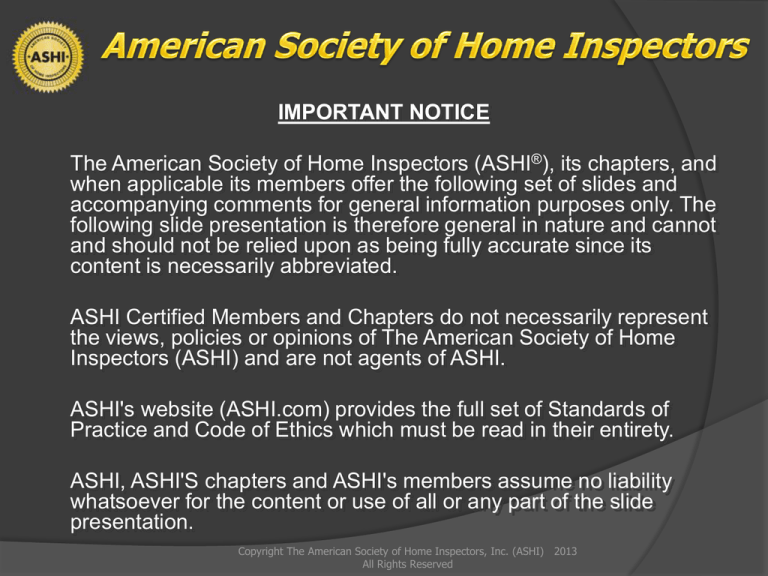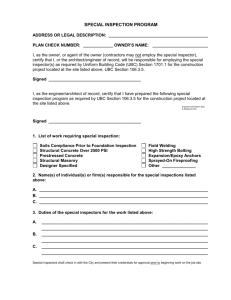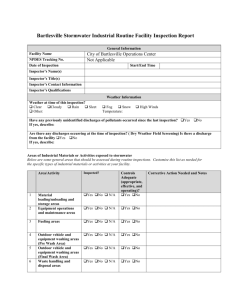
IMPORTANT NOTICE
The American Society of Home Inspectors (ASHI®), its chapters, and
when applicable its members offer the following set of slides and
accompanying comments for general information purposes only. The
following slide presentation is therefore general in nature and cannot
and should not be relied upon as being fully accurate since its
content is necessarily abbreviated.
ASHI Certified Members and Chapters do not necessarily represent
the views, policies or opinions of The American Society of Home
Inspectors (ASHI) and are not agents of ASHI.
ASHI's website (ASHI.com) provides the full set of Standards of
Practice and Code of Ethics which must be read in their entirety.
ASHI, ASHI'S chapters and ASHI's members assume no liability
whatsoever for the content or use of all or any part of the slide
presentation.
Copyright The American Society of Home Inspectors, Inc. (ASHI) 2013
All Rights Reserved
Welcome
<Your Name and Chapter>
Copyright The American Society of Home Inspectors, Inc. (ASHI) 2013
All Rights Reserved
Introduction
Why you should use an ASHI® Certified
Inspector?
To help you understand what a home
inspection is and is not
The home inspection process
Copyright The American Society of Home Inspectors, Inc. (ASHI) 2013
All Rights Reserved
Agenda
How to choose a professional home inspector.
About ASHI®
What is an ASHI® Certified Inspector?
What is a home inspection?
Why all real estate agents should recommend a
home inspection.
Why you should also recommend a home inspection
for pre-sale and new construction.
Buying a house is one of the
biggest investments someone will
ever make
Buyers do not want surprises (and
neither do real estate professionals).
How to Choose a Professional Home Inspector
A consumer should look for the following items when
selecting a home inspector:
Should be professional and an ASHI Certified Inspector®.
Subscribes to the ASHI Standards of Practice and ASHI
Code of Ethics.
Mandatory continuing education – 20 hours per year.
Why you should you use an ASHI Certified Inspector
ASHI was founded in 1976.
America’s oldest professional home inspection
organization.
ASHI‘s Standards of Practice and Code of Ethics are the
most respected.
ASHI is the premier non-profit home inspection
association.
Goal – to build customer awareness of the importance of
a quality, professional home inspection while maintaining
the highest standards in the profession.
What is an ASHI Certified Inspector® (ACI®)
ASHI’s ACI program is officially recognized by
the National Commission on Certifying
Agencies (NCCA), a third-party independent
certifying agency.
ASHI is the only nonprofit association for home
inspectors accredited by an outside certifying
organization, NCCA. Some home inspection
associations offer their members “self-made”
certifications that have no independent third-party
credibility behind them.
What is an ASHI Certified Inspector (ACI)
Has passed the ASHI Standards of Practice and Code of
Ethics Exam.
Has passed the National Home Inspector Examination®.
• A 4 hour, 250 question exam that has been adopted in whole or in
part by approximately 37 states as part of their pre-licensing
requirements to measure entry level Home Inspector competency.
What is an ASHI Certified Inspector (ACI)
Must complete 250 fee-paid home inspections.
Must obtain 20 education credits annually to keep the
ASHI® certification.
Must subscribe to the ASHI Standards of Practice and
Code of Ethics.
Inspection report format must be approved by ASHI to
ensure compliance with the ASHI Standards of Practice.
Although outside the scope of ASHI’s ACI
program, many home inspectors offer
additional services such as:
Radon testing
WDI/termite inspections
Mold evaluations
Well water testing
Septic inspections
and more.
Meeting the ASHI Standards is NOT the same
as having an ASHI Certified Inspector.
Many inspectors claim “my inspections are
conducted to ASHI Standards” falsely implying
they are ASHI Certified.
Only ASHI Certified Inspectors can use this logo.
Your Part in the Inspection
We encourage your participation in the inspection.
• Gives you one-on-one time with your client.
• Lets you see the issues first hand.
o Helps with negotiation of issues.
Shows your client you care.
Provides a comfort factor for your client.
Be available to answer any questions.
Why a Home Inspection?
Convey the condition of the home.
Increase buyer confidence.
A better educated buyer will be a better educated
home owner.
A very inexpensive investment with a high rate of
return!
Approximately 0.0020 or 0.2% of the cost of the home.
An ASHI inspector will inspect and report on
readily accessible, visually observable
systems and components listed in the SoP
that are:
• Not functioning properly.
• Significantly deficient.
• Unsafe.
• Near the end of their service life.
A home inspection is not an engineering or
architectural evaluation or meant to ensure
compliance with regulatory requirements such as
codes, regulations, laws, ordinances, etc.
It is not advice on price, purchase, request for
remedy or repair.
For a complete list of the General Limitations of a
home inspection, see the ASHI SoP.
• Cosmetic issues are not reported.
What a Home Inspection covers
Structural Components
Exterior Components
Roofing
Plumbing
Electrical
Heating
Air Conditioning/Heat Pumps
Interior Components
Insulation and Ventilation
Fireplaces and Solid Fuel Burning Appliances
Structural Components
Exterior
Foundation type.
Drainage, grading, surface drainage.
Exterior finishes.
• Siding, wood, brick, stone.
• Windows, doors.
• Walkways, patios, driveways.
• Eaves, soffits and fascia.
Roof and Attic
Roof covering.
Accessories.
• Stacks, chimneys, skylights and flashing.
Gutters and downspouts.
Attic structure.
Ventilation and moisture.
Plumbing
Water main and shut-off.
Interior water supply and distribution systems.
Waste and vent systems including fixtures.
Sump pumps.
Water heater.
Electrical
Service drop and entrance.
Grounding.
Interior components of service and sub panels.
GFCI’s
Representative number of light fixtures, switches and
receptacles.
Branch circuit wiring including the presence of solid
conductor aluminum wire and knob-and-tube wire.
Redneck
Heating & Air Conditioning
Identify the system.
Vent systems, flues and chimneys.
Condition of unit.
Furnace filter.
Ducts.
Excludes humidifiers.
Interior Rooms, Kitchen, Bathrooms and Garage
Walls, ceilings & floors.
Steps, stairways and railings.
Countertops, cabinets.
Doors and windows.
Garage doors.
Garage door openers.
Insulation and Ventilation
Insulation and vapor retarders in unfinished
spaces.
Ventilation in attics and foundation.
Mechanical ventilation system.
Fireplaces and Solid Fuel Burning Appliances
Chimney
Fireplace
• The Chimney Safety Institute of America and National
Fire Protection Association recommend a NFPA 211
Level II inspection with every real estate transaction
Vents
Wood stoves
General Limitations
Inspectors are not required to:
• Enter an area that is unsafe.
• Move personal property.
• Dismantle any system or component.
• Determine remaining life.
• Provide specific repair information.
Why a Pre-listing Inspection?
Having issues remedied before prospective buyers
view the home saves your client time and money
during negotiations.
Enhances the marketability of the house leading to
faster sales and better prices.
•
Show receipts for repairs.
•
Creates trust, confidence and credibility with buyer.
Why New Construction Inspections?
Just because the house is new does not mean it is
perfect.
A “new construction” inspection can point out
issues that can be repaired before your client
takes possession.
An inspection before the 1 year warranty has
expired also provides your client with
issues/concerns that the contractor may need to
address.
Summary
Why you should have a home inspection?
Provide your buyer with objective information
regarding the condition of the systems and
components of the home as inspected at the time of
the home inspection.
Why you should use an ASHI Certified
Inspector?
Professionalism
Field Experience
Continuing Education Requirements
Subscribes to a recognized SoP and CoE
Thank You
<Your name and Chapter>






